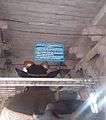Masilamaniswara Temple, Thiruvaduthurai
Masilamaniswara Temple (மாசிலமணீஸ்வரர் கோயில், திருவாவடுதுறை)[1] is a Hindu temple dedicated to Hindu god Shiva, located in the village Thiruvaduthurai, located 22 km from the South Indian town, Kumbakonam and 14 km from Mayiladuthurai, Tamil Nadu. It is one of the shrines of the 275 Paadal Petra Sthalams. The temple is referred to in the verses of Tevaram, the 7th century Tamil Saiva canon by Tirugnana Sambandar, Appar and Sundarar.
| Masilamaniswara Temple | |
|---|---|
| Religion | |
| Affiliation | Hinduism |
| District | Mayiladuthurai |
| Deity | Masilamaniswarar (Shiva) Oppilamulaiyar (Parvathi) |
| Features |
|
| Location | |
| Location | Thiruvaduthurai |
| State | Tamil Nadu |
| Country | India |
 Location in Tamil Nadu | |
| Geographic coordinates | 10°29′N 78°41′E |
| Architecture | |
| Type | Dravidian architecture |
| Temple(s) | 1 |
Legend
Legend associates the temple with the saivite saint Tirumular (6th century CE).[2] Tirumular saw a herd of cows lamenting the death of their herdsmen named Moolan. Being a siddha, he entered into the body of Moolan, came back alive to serve as the herdsman.[2] It is believed that he was coming from North to South India to meet sage Agastya. When he went back to the place where he left his original body, he did not find it. Considering it as a divine play, he continued to remain in the body of Moolan for the rest of his life.[3]
As per another legend, Parvathi was cursed to become a cow and she worshipped Shiva to attain her original form.[4] The legend is closely associated with this temple, but is also associated with other temples like Thenupuriswarar Temple at Patteswaram, Aavoor Pasupatheeswaram and Tirukogarnam near Pudukkottai.[2]
The temple
The temple is located 12 km away from Mayiladuthurai and 24 km away from Kumbakonam. The temple has a five tiered Rajagopuram with elevated stone walls separating the second, third and fourth precinct. The images of the presiding deity, Masilamaniswarar, in the form of Shiva lingam occupies the main sanctum facing east. The shrine of the consort of Masilamaniswarar, Oppilamulaiyar faces west. The third prakaram has a separate shrine for the saivite saint Tirumular. The temple has three water bodies located at various places inside the temple. The Thiruvaduthurai Adheenam is located in the premises outside the fourth precinct.[5]
Literary references
The temple is revered in the verses of Tevaram, the 7th century Saivite canonical work by the three saint poets, namely, Appar, Sambandar and Sundarar. The temple is reverred by Sambandar in the third Tirumurai in one verse, Appar in five and Sundarar in two verses.[6][5]
- "இடரினும் தளரினும் எனதுறுநோய்
- தொடரினும் உனகழல் தொழுதெழுவேன்
- கடல்தனில் அமுதொடு கலந்தநஞ்சை
- மிடறினில் அடக்கிய வேதியனே
- இதுவோஎமை ஆளுமா றீவதொன்றெமக் கில்லையேல்
- அதுவோவுன தின்னருள் ஆவடுதுறை அரனே."
[6] translating to
- "when I am undergoing sufferings.
- when I am depressed in spirits.
- when my big karmams follow me I shall wake up from sleep worshipping your feet.
- Civaṉ who gave out the Vētams and who controlled the poison which was mixed with the nectar in the ocean of milk and made it stay in the neck!
- Civaṉ in Āvaṭutuṟai!
- if there is nothing to give to us.
- is this way you admit us as your protege?
- is your sweet grace like that?".[7]
Citations
- ta:திருவாவடுதுறை கோமுக்தீசுவரர் கோயில்
- Schottenhammer 1997, pp. 299-300.
- A., Rajaram Brammarajan (2000). "Siddhar Poems From Tamil: An Introduction". Indian Literature. Sahitya Akademi. 44 (195). JSTOR 23343022.
- V., Meena (1974). Temples in South India (1st ed.). Kanniyakumari: Harikumar Arts. p. 38.
- Masilamaniswarar Temple, Thiruvaduthurai 2012.
- Tirugnanasambandar 2002, pp. 8-10.
- Moondram Thirumurai, Thiruvaduthurai 2012.
References
- "Masilamaniswarar Temple, Thiruvaduthurai". Thevaaram.org. 2012. Retrieved 26 June 2012.
- "Moondram Thirumurai, Thiruvaduthurai". Thevaaram.org. 2012. Retrieved 26 June 2012.
- Schottenhammer, Angela (1997), The Emporium of the World: Maritime Quanzhou, 1000-1400, Netherlands: Die Duetsche Bibilothek - CIP -Einheitsaufnahme, ISBN 90-04-11773-3CS1 maint: ref=harv (link).
- Tirugnanasambandar (2002). Sambandar Tevarm -3 (PDF). projectmadurai.org. Retrieved 19 August 2012.CS1 maint: ref=harv (link)
External links
| Wikimedia Commons has media related to Thiruvaduthurai Temple. |
Gallery
 Flagpost
Flagpost Nandhi
Nandhi Nandhi (right view)
Nandhi (right view) Nandhi (left view)
Nandhi (left view) Balipeetam
Balipeetam Amman shrine
Amman shrine